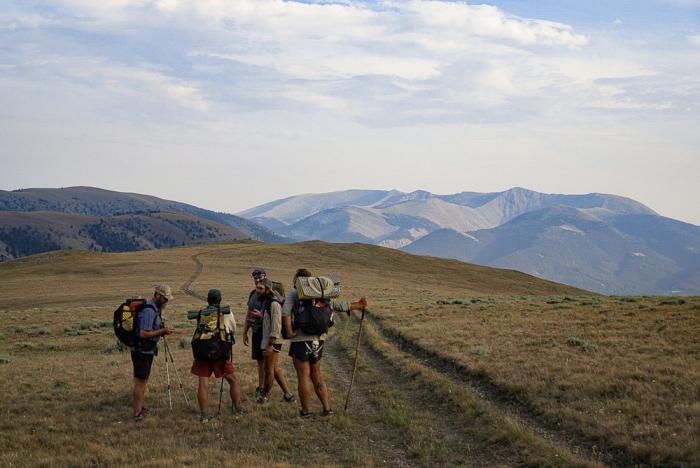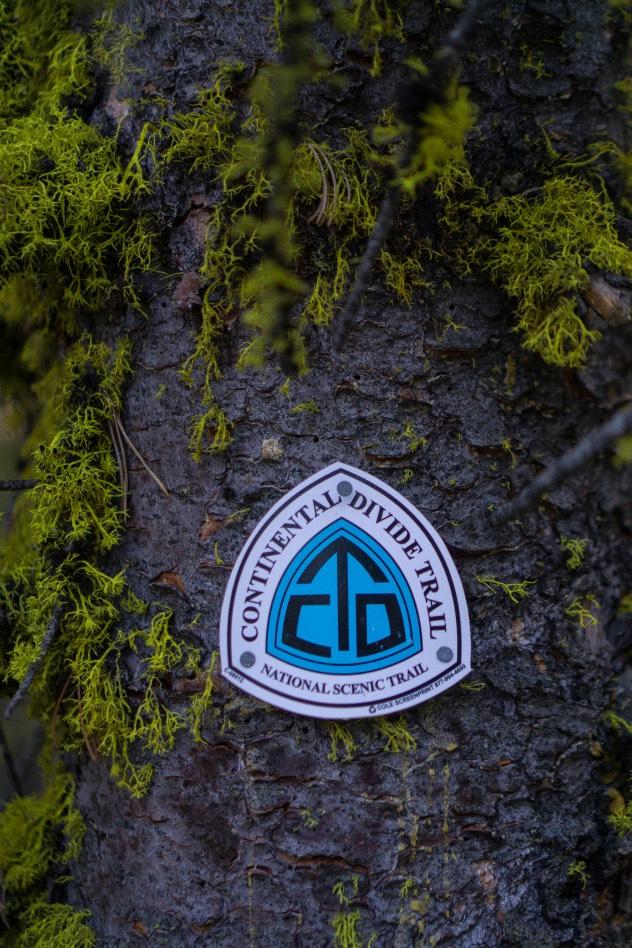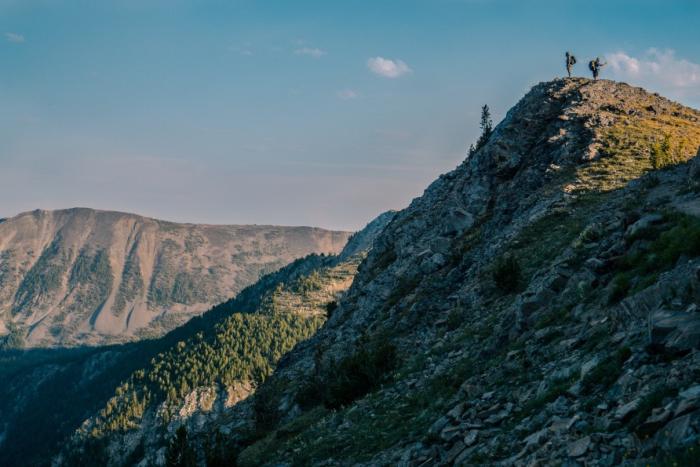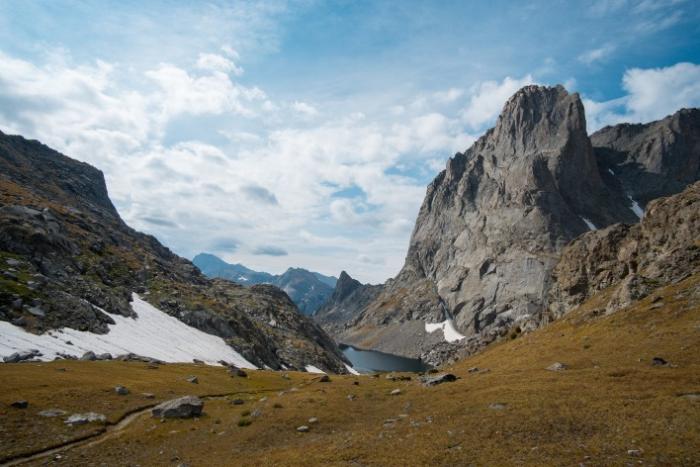

Winter came early to Colorado and people were leaving the backcountry with the first snow. Only the hikers remained, adding to the animal tracks that followed the Continental Divide Trail (CDT). The aspens held onto their leaves, golden against the snowy peaks, and the quiet was no longer punctuated by off-road vehicles. The animals became less inhibited as the humans disappeared, letting us into a territory that felt truly wild.
The CDT traverses nearly 3,000 miles through the Rocky Mountains from Canada to Mexico, often entering wildernesses known for their isolation, wildlife and volatile conditions. We crossed countless burns and cow-trampled pastures, climbing over wiry blowdowns and between stubborn barbed-wire gates. Though there were prosaic sections along forest roads, an area of grandeur always awaited us farther on.
The CDT is reputedly the most difficult trail of thru-hiking’s Triple Crown (the three biggest trails in the United States — the Appalachian, the Pacific Crest and the Continental Divide), yet it rarely lived up to its “Embrace the Brutality” tagline. The Guthooks hiking trail app has eliminated many navigational challenges and I generally didn’t notice our isolation. Fewer people used to attempt the CDT, but the growing number of hikers silenced any fears of solitude.

I began at the Canadian border in July with two friends from the Appalachian Trail but later floated between groups as we met more hikers along the way. Though I was apprehensive about the weather and bears, I had seriously fallen for this freeing lifestyle and never questioned my ability to finish the trail. I knew that my tenacity, experience and planning would get me to Mexico.
As much as I had prepared for obstacles, I hadn’t anticipated the fires, the sexism or the aggressive domestic animals that shook my determination. The fears and assumptions that most people associate with living in the Rockies were never actual factors on the trail — it was the weight of my expectations that eventually drove me from the CDT.
“Make noise in the willows and carry bear spray. I don’t want to write a report about your mauling,” my friend Erika advised before I left. As a reporter for Jackson Hole News & Guide, she is well-versed in backcountry injuries, animal attacks and the rare individuals who get disintegrated in geothermal pools.
We began the trail with one can of bear spray, oblivious to and soon conflicted by our varying walking speeds, but relaxed after weeks without incident. We camped near water, ate dinner beside our tents and slept with our food. I tuned out the fear-mongering that had weighed on me before the trail, grateful to find most of it unfounded.

The CDT is unfinished and more flexible than other trails, and I frequently ventured into less-trodden terrain. The established route has its vistas and wildlife encounters, but I often found greater enjoyment diverging from the dirt roads and cow pastures. In Beaverhead-Deerlodge, an impulsive foray on an alternate route revealed a valley full of elk beneath hazy, jagged cliffs. We were soon slogging our way through bogs, streams and pouring rain near the Wyoming border, and I shivered silently under my emergency poncho as two bull moose peered back at us through the foliage.
I was not afraid of the wildlife. I rounded a bend to a startled grizzly and laughed, too shocked to reach for bear spray. A black bear surprised me as much as I frightened it, guarding a large elk carcass in the ravine beneath me outside Colorado’s Wolf Creek Pass. It ran, as they always do, and was soon replaced by what appeared to be a wolf, its thick white fur juxtaposed with the blood along its jawline. Although I may never blend in with the wilderness as gracefully as the fauna, I do feel safe.
For all the excitement of surprising scenery and wildlife, the unexpected was not always pleasant, and the early cold and snow made my lack of adequate preparation evident. Thru-hikers rely on chance, balancing the benefits of an item with the cost of its weight, and few are willing to shoulder “just in case” items. But we carry our fears in different ways, both physically and mentally.
I did lose sleep over aggressive sheepdogs and grow weary of the cows, so immersed were we in the cattle country that has contaminated our streams and damaged public lands. My pack was far too small and my quilt too light, and a flimsy emergency poncho was vastly inadequate for the Colorado hail and thundersnow. I moved languidly through the Wind River Range and spent a night on a bathroom floor, discovering that water treatment is not optional.

Nor had I planned for the exclusion and sexism that wore down my resolve and pushed me away from my friends. The Appalachian Trail had been a convivial introduction to the hiking community, with the sole objectives of challenging myself and enjoying the novelties. But CDT hikers, myself included, focused more on the status of high mileage, trendy gear and light pack weights. There was a clash of egos and experience, by virtue of the CDT being the final trail of the Triple Crown. I soon found myself disenchanted with this new mentality.
I was particularly disappointed by many of the male hikers; though men in the towns are often problematic, I’d previously extolled my male companions for making the trail community welcoming to women. Yet I often felt compelled to overcompensate for my gender on the CDT, staying silent and pushing myself incessantly. I internalized the jokes and criticisms and smoldered under their praise — I knew that I was being measured on a weighted scale.
But more important than the daily discomforts were the events of actual harassment and abuse. One man followed me around a store until I went into another room and shut the door. A cameraman working on a CDT documentary shoved his hand up a friend’s sports bra while attaching a microphone to her shirt. I also received a message from a girl hiking behind me, asking if anything had happened in the several days I spent alone with a particular male hiker. He had just sexually assaulted her in their motel room.
“It’s not our fault more women don’t want to hike,” one man said, and I began to view the community I had once admired as one of gas-lighting and disregard for the problems within. Though they are good people and friends, these men didn’t recognize the toll these circumstances took on us or even necessarily want to know. My friend Phantom faced protests from her group each time she shared instances of harassment. I was told that my feelings were invalid and to “Get a trail boyfriend and work out some tension.”
And the girl who was assaulted in the motel room?
“Well, she drinks a lot.”
The storms and snow effectively closed the high routes in Colorado and I realized I would not be happy finishing the trail on the lower alternatives. In my months on the CDT, I had never felt able to hike the way I wanted, often acquiescing to group dynamics rather than doing what would make me happy. I decided to reach Mexico on my own terms via the Arizona Trail, without the confusion of others’ plans and opinions.
I skipped from Silverthorne to Salida to hike my last week with Phantom. My friends would be taking me to the Arizona Trail (an 800-mile trail that runs from Utah to Mexico) soon and there was a weather opening to attempt the CDT route through San Juan National Forest. There would be snow and extreme wind, cold and exposure, and success was unlikely, but I knew that that was how I wanted to leave the CDT.
That final week was my favorite of the entire trail. Pam Houston wrote, “If you can't fall in love with the San Juans during the third week of September, you can’t fall in love,” and it held true into early October. The elk gathered on the alpine tundra and the peaks were tall and endless under crisp blue sky. I slipped in mud, slammed my worn trail runners through the frozen snow crust and breathed the thin air, finally acclimated to the elevation after over a month in Colorado.

From 13,000 feet we could see the microclimates form and pass, and experience the solitude of mountains temporarily deserted by people heading for warmer lands. For the first time I hiked without any preconceptions or desire to reach a destination — my thru-hike was officially over.
We were forced back to Spring Creek Pass by ice and sheer snowfields, and chased out of the mountains by a snowstorm raging at 12,000 feet. What started as a half-joking attempt to “crush the San Juans” became a humbling lesson in ego and acceptance.
On October 9 I took my last step on the CDT, exactly one year after finishing the Appalachian Trail. Before the CDT, I couldn’t have conceptualized skipping so many miles or quitting any more than I could have predicted the murderous dogs or early cold. But I will return someday, and I’m glad I did not crush the San Juans or conquer the mountains, rivers and snow.
I can only go back without expectations and can only hope for a tie — to fully and finally “Embrace the Brutality” of the Continental Divide Trail.
Photos by Danielle Vilaplana. Photos are copyright protected and may not be reproduced without the permission of the photographer.